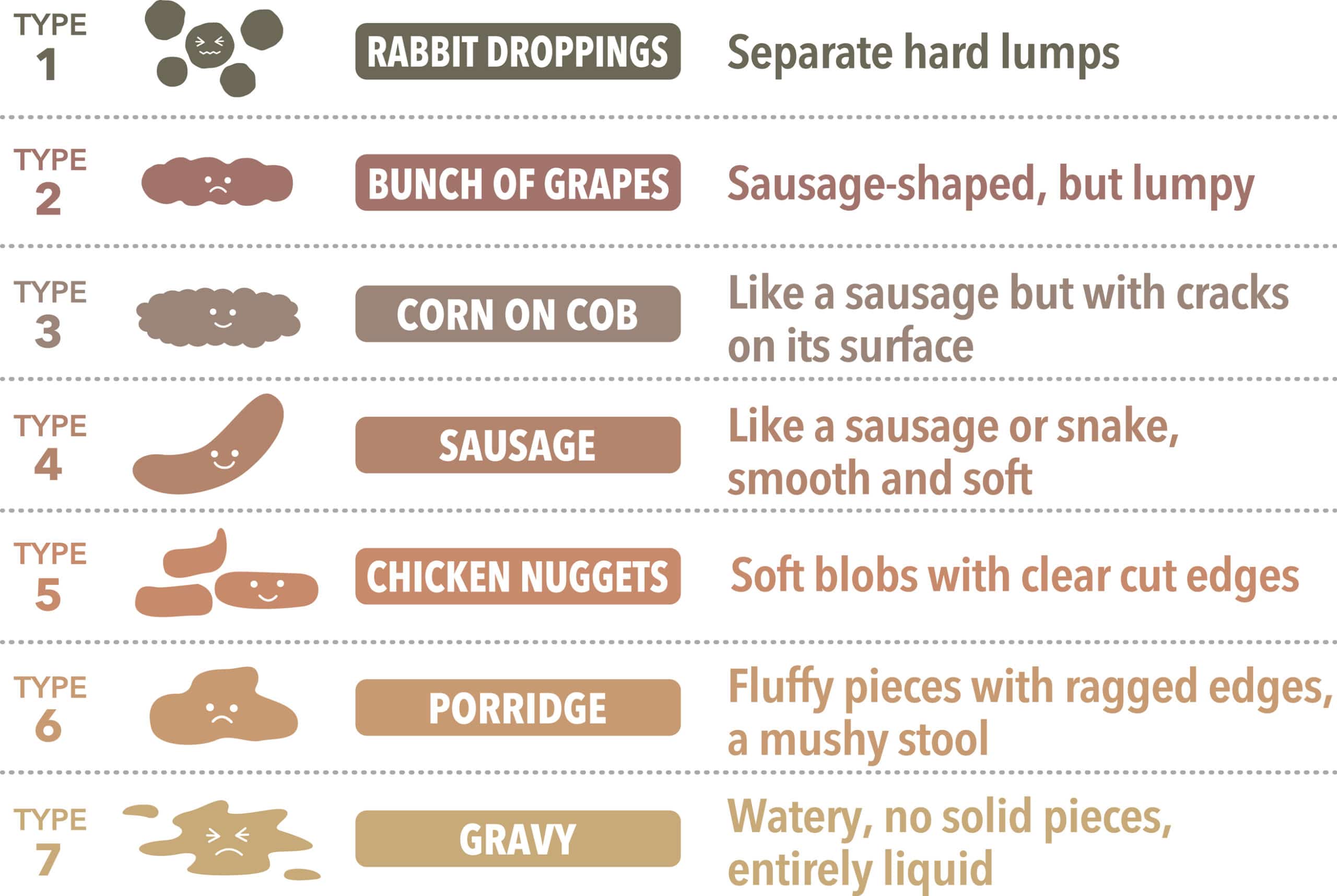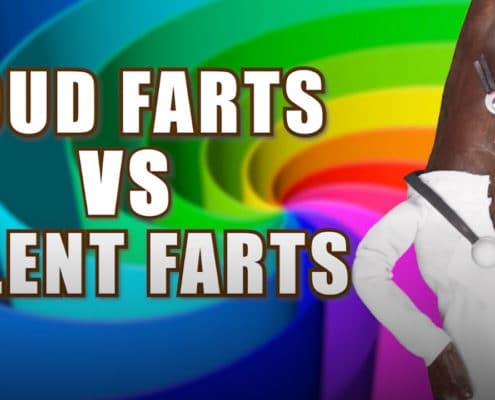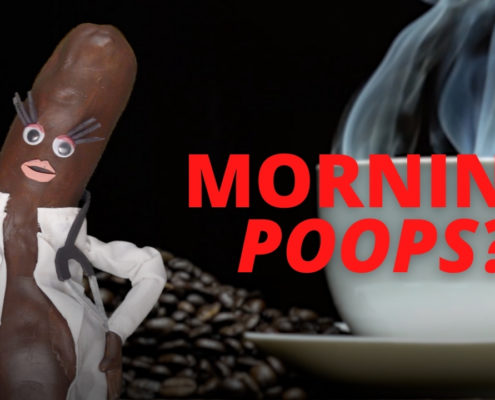What does the color of my poop mean?
What Does The Color Of My Poop Mean?
(What The Color and Consistency of Your Poop Says About Your Health!)
Click Here For Transcript of "What Does My Poop Mean" Video
Well, color me poopy!
What does the color of your POO say about YOU!
Poo Doctor here to talk about the chic color that your poo should be this season and the other colors I hope you avoid.
Brown is the new brown, and it’s the old brown, too.
What I’m trying to say is… your poo should be brown.
But what does it mean if your poop is black, green, white, red, or yellow?
It’s all about the B word: bilirubin! See, it starts with- Ah poop, I’m out of time here but click on the link below to see what the color of your POO says about YOU!
Until then, Like for good poop. Subscribe for great poop!
Have you ever considered that your body communicates through the color of your poop? It might sound a bit unusual, but the hues you see in the toilet bowl are often a reliable barometer of your overall health. Like a traffic light that signals when to go, caution, or stop, the shades of your stool can alert you to what’s happening inside your body.
Exploring the significance of poop color isn’t just for the curious—it’s for anyone invested in maintaining their health. Think of it as a daily check-in from your digestive system. This isn’t about diagnosing yourself in the bathroom; it’s about knowing when to pay attention and perhaps when to reach out to a healthcare provider.
In the forthcoming article, the mysterious palette of poop colors will be decoded. Whether it’s a reassuring earthy brown, a warning red, or an unusual green, each color has a story to tell. And understanding these stories is part of taking charge of your health journey.
So, before flushing away the evidence, take a moment to notice what’s left behind—it could be more important than you think. Feel free to share this insight; it’s a conversation that could be both eye-opening and potentially health-saving for friends and family across your social networks and email contacts. Stay tuned, and let’s keep learning about the body’s unique ways of informing us.
What is Poop?
Poop, or stool, is the body’s way of eliminating waste and undigested material. This waste includes not only undigested parts of the food eaten but also bacteria, cells shed from the lining of the intestines, and substances delivered by the liver to aid digestion.
The journey of creating poop begins in the stomach and continues as the digested material moves through the small intestine. Here, nutrients are absorbed, and what can’t be used by the body moves on to the large intestine, also known as the colon. In the colon, water is absorbed from this material, transforming it from a liquid to a solid state as it becomes the stool most are familiar with.
As it progresses through the colon, the forming stool gathers all the waste elements, getting its final touches before it exits the body. The stool’s color, consistency, and form can change based on diet, health conditions, and a host of other factors, providing clues about your health.
Understanding the basics of what poop is and how it’s formed is essential for recognizing changes that might indicate health issues. It’s a part of the body’s complex waste management system and a critical indicator of internal well-being. So, keeping an eye on these aspects can be a proactive way to stay on top of your health.
What is Healthy Poop?
Healthy poop is an excellent indicator of a well-functioning digestive system. Typically, a healthy stool is medium to dark brown, has a soft to firm consistency, and is shaped like a sausage or snake, smooth and with few cracks on the surface. This consistency and form mean that the digestive tract processes meals efficiently and the body effectively absorbs nutrients.
The regularity of bowel movements also plays a key role in defining what’s healthy. Most experts agree that there’s a wide range of normal bowel movements, typically three times a day to three times a week. Consistency is crucial; sudden changes in the frequency, texture, or color of stool can suggest dietary changes or potential health issues.
Furthermore, healthy poop should not cause pain or require excessive straining during bowel movements. It should pass easily and leave you feeling like you’ve completely emptied your bowels. The absence of regular, comfortable bowel movements may warrant a closer look at your diet or a discussion with a healthcare provider to rule out potential issues.
Being familiar with what constitutes healthy poop helps maintain not just digestive health but overall well-being. Regularly monitoring your bowel habits can provide early indications of health changes and prompt timely dietary adjustments or medical consultation when necessary.
Poop Color: What It Means and When to Worry
The color of your stool can vary greatly, and while many shades are considered normal, others might indicate a need for medical attention.
Understanding what each color signifies can help determine if a doctor’s visit is necessary.
1. Brown
Brown is the most common stool color and is considered normal and healthy. The color comes from bile, a digestive fluid produced in the liver that is crucial for digestion and fat absorption.
If your stool is consistently brown, it’s a good sign that your digestive system is functioning correctly.
2. Green
Green poop can occur when you eat a lot of green vegetables, such as spinach or kale, or when food moves through the intestines too quickly, and the bile doesn’t have time to break down completely.
While it can be startling, green stool isn’t usually a cause for concern unless accompanied by other symptoms like diarrhea.
3. Yellow
Yellow poop can be caused by a reduction in bile production or a condition that prevents bile from reaching the intestines. This can occur with liver or gallbladder disorders.
If the stool is also greasy and foul-smelling, it may indicate excess fat due to malabsorption disorders like celiac disease.
4. Black
Black poop can be a result of consuming iron supplements, black licorice, blueberries, or other dark foods. However, if it appears tarry and has a foul smell, it could indicate bleeding in the upper gastrointestinal tract.
This type of black stool is a medical emergency and should be addressed by a healthcare provider immediately.
5. Red
Red poop can be alarming and is sometimes caused by bleeding in the lower intestinal tract, such as from hemorrhoids or anal fissures. However, it can also result from eating red-colored foods like beets or cranberries.
If you haven’t eaten red foods and notice red in your stool, it’s important to consult a doctor.
6. White or Clay-Colored
Pale poop or stool that is white or clay-colored can indicate a lack of bile, which may suggest a blockage of the bile duct or severe liver disease. This color change can also occur if you’ve taken certain medications, like those for diarrhea.
See a healthcare provider if your stool is white or clay-colored and not due to medication.
Each stool color has its implications, and while dietary choices often explain temporary changes, persistent color changes, especially when accompanied by other symptoms, should prompt a medical consultation to rule out more serious conditions.
Causes of Unhealthy Poops
Unhealthy stools can indicate disruptions in digestive health or deeper underlying health issues. Recognizing the factors that contribute to bowel movement changes can help identify when to seek medical advice.
Below are several common causes of unhealthy poops, which can affect stool color, consistency, and frequency. Understanding these can guide you in maintaining digestive wellness or addressing concerns with a healthcare provider.
1. Poor Diet
A diet low in fiber and high in processed foods can lead to constipation and produce challenging, difficult-to-pass stools. Fiber-rich foods, such as vegetables, fruits, and legumes help create bulk and soften stool, making it easier to pass.
Inadequate water intake can also contribute to this issue by drying out the colon, making stool passage more challenging and less frequent.
2. Medications
Certain medications can adversely affect bowel movement regularity and consistency. For example, iron supplements and narcotics can cause constipation, while antibiotics may disrupt the gut’s microbial balance, leading to diarrhea.
Always review the side effects of any medication and discuss potential impacts on digestion with a healthcare provider.
3. Stress
High levels of stress impact the entire body, including the digestive system. Stress can speed up or slow down digestion, leading to diarrhea or constipation.
Chronic stress can exacerbate gastrointestinal problems, highlighting the importance of stress management techniques for maintaining regular bowel movements and overall health.
4. Intestinal Infections
Infections caused by bacteria, viruses, or parasites can lead to diarrhea. These microorganisms often enter the body through contaminated food or water and can cause acute gastrointestinal symptoms, including cramping, nausea, and altered stool consistency.
Proper hygiene and food safety measures are critical in preventing these infections.
5. Digestive Disorders
Individuals suffering from chronic conditions such as irritable bowel syndrome (IBS), Crohn’s disease, and ulcerative colitis may experience recurring instances of diarrhea, constipation, or both. These conditions may cause inflammation in the digestive tract, which disrupts normal digestion and absorption, leading to irregular bowel movements.
Diagnosis and management by a healthcare professional are essential for controlling symptoms and maintaining quality of life.
Recognizing the factors contributing to unhealthy stools can prompt timely dietary adjustments and medical consultations, ensuring that digestive health is balanced and overall well-being is supported.
Strategies to Improve Poops
Maintaining healthy bowel movements is crucial for overall health and well-being. The quality of your stools reflects the state of your digestive health, which can be influenced by diet, lifestyle, and medical conditions.
Here are several strategies designed to improve the quality of your poops, aiding in better digestive health and comfort. Implementing these methods can lead to more regular, healthier stools and may alleviate common digestive discomforts.
1. Increase Fiber Intake
Incorporating more fiber into your diet is one of the most effective ways to improve stool consistency and frequency. Foods rich in fiber, such as fruits, vegetables, and legumes, help to bulk up and soften the stool, making it easier to pass.
Aim for a gradual increase in fiber to allow your body to adjust, and drink plenty of water to help fiber do its job effectively.
2. Stay Hydrated
Drinking sufficient water is essential for softening stool and promoting smooth bowel movements. Dehydration can lead to hardened stool, making it more difficult and uncomfortable to pass. Aim for at least 8 cups of fluids daily, and consider more if you are active or live in a hot climate.
Fluids help move fiber through the digestive tract and prevent constipation.
3. Exercise Regularly
Physical activity helps stimulate intestinal contractions, which are essential for moving stool through the colon.
Regular exercise, such as walking, swimming, or cycling, can significantly improve digestive health and reduce the time food travels through the large intestine, thus limiting the amount of water absorbed from stool back into the body.
4. Establish a Routine
Creating a regular bathroom schedule can help regulate bowel movements. Try to respond to your body’s natural urges rather than ignoring them, as postponing bowel movements can lead to harder and drier stools.
Setting a regular time each day, such as after meals, can help train your digestive system for more predictable bowel activity.
5. Evaluate Your Diet
Monitor your intake of foods that might irritate your digestive system. Some individuals find that reducing or eliminating dairy, gluten, or excessively spicy foods can significantly improve stool quality and relieve gastrointestinal discomfort.
Keeping a food diary can be a helpful way to identify foods that might be causing issues with your bowel movements.
6. Consider Probiotics
Probiotics can help maintain or restore the gut flora, which is critical for healthy digestion and bowel movements.
Consuming probiotic-rich foods like yogurt, kefir, and sauerkraut or taking a probiotic supplement can introduce beneficial bacteria into the digestive tract, potentially improving stool consistency and frequency.
These strategies offer practical ways to improve the regularity and quality of your bowel movements. By implementing these tips, you can support your digestive health and contribute to your overall well-being.
Frequently Asked Questions About Digestive Health
1. What are the signs of a healthy digestive system?
A healthy digestive system manifests through regular, consistent bowel movements, typically one to three times a day, with well-formed and easy-to-pass stools. The absence of regular discomfort such as bloating, gas, diarrhea, or constipation also indicates good digestive health.
Additionally, eating a variety of foods without discomfort suggests that the digestive system is effectively processing and absorbing nutrients.
2. How can stress affect digestive health?
Stress has a significant impact on the digestive system. It can cause the esophagus to spasm, increase the acidity in the stomach, and cause bloating and pain. Chronic stress can lead to conditions like gastritis or ulcerative colitis.
Managing stress through meditation, regular exercise, and sufficient sleep can help mitigate these adverse effects and promote a healthier digestive system.
3. Are there any common digestive health myths that should be debunked?
One common myth is that consuming large amounts of dairy products is necessary for good digestive health due to their calcium content. However, dairy can trigger digestive distress and symptoms like bloating, gas, and diarrhea for many people.
Another myth is that a detox diet is required to cleanse the digestive system. The body is naturally equipped with organs such as the liver and kidneys that effectively remove toxins.
A balanced diet rich in fiber, fluids, and regular physical activity is sufficient to maintain good digestive health.
These questions cover essential aspects of digestive health, provide clarity on how to maintain a healthy digestive system, and debunk common misconceptions that can lead to unnecessary dietary and lifestyle changes.
Conclusion: Understanding Digestive Health and Poop Color
Navigating the nuances of digestive health and understanding what your poop color signifies are key steps toward maintaining overall wellness. From recognizing the impact of diet and exercise to interpreting the various stool colors, this guide provides essential insights for anyone looking to enhance their digestive health.
If this information has enlightened or helped you, please share it with friends and family through social media or email. Spreading awareness about these fundamental health indicators can empower others to make positive changes in their lives, leading to improved well-being.
Fixing poop issues
Though fixing your poop issues may seem daunting, it’s often easier than you may think. You can help fix so many of your digestive and bathroom issues, such as gas and bloating, and improve your overall health with a patented molecule that is backed by Ivy League doctors! Click here to learn more about this groundbreaking poop fix formula and to place your order TODAY.
Types of poop encountered are categorized by the Bristol Stool Chart. This chart is a generalized indicator of how or why different types of poops look and feel a certain way. The 7 types of poop are broken up into categories based on a 2,000-person study!

Does your poo look this good? If you have Bristol Type 3 or 4 – your poop is considered “normal”! Bristol Type 1 or 2, is where the poop is hard and difficult to pass, are indicative of constipation. Often, these types of stool can be painful to pass – but don’t worry – Doctor Poo has a recommended healthy-gut switch solution…just keep reading!
Should you ever worry about your poop?
Always consult your healthcare provider if you have any concerns about what your poop means. People are asked to call their healthcare providers if: They experience severe levels of abdominal pain or discomfort with diarrhea that does not go away when they poop or fart. Also, if diarrhea is accompanied by a fever of 101 degrees Fahrenheit or higher, chills, vomiting, or fainting, call your physician immediately.
What is unhealthy poop?
An unhealthy poop is when one poops too often (hence, your doctor asking you if you poop more than three times daily) or not poops often enough (As such, less than three times a week) and also excessive straining when pooping. Poop that is colored red, black, green, yellow, or white. greasy or fatty stools is unhealthy.
Help fix so many of your digestive and bathroom issues, such as gas and bloating and improve your overall health with this patented molecule that is backed by Ivy League Doctors by clicking here!
Doctor Poo Provides More Valuable Answers for Those Hard-to-Ask Questions Below:













Trackbacks & Pingbacks
[…] post What does the color of my poop mean? appeared first on SANESolution | Proven & Powerful […]
[…] post What does the color of my poop mean? appeared first on SANESolution | Proven & Powerful […]
Comments are closed.